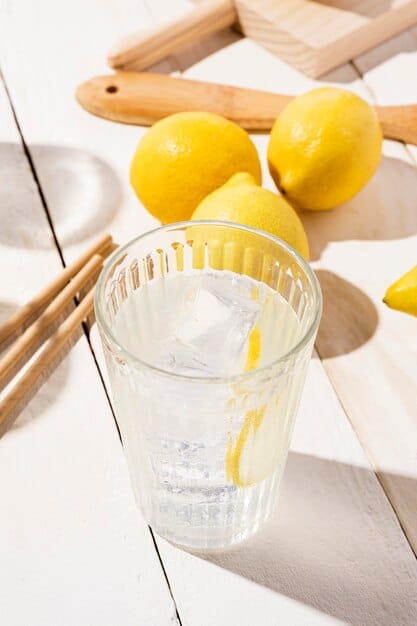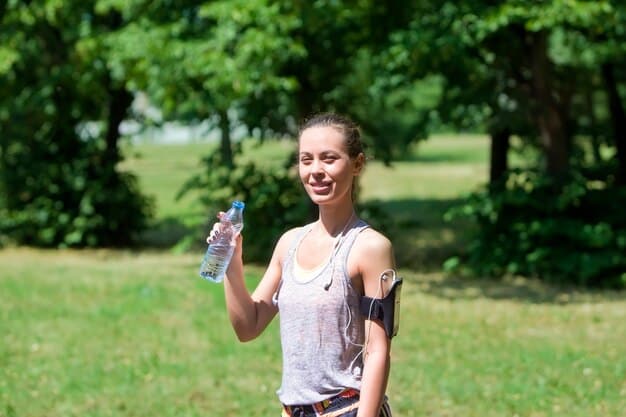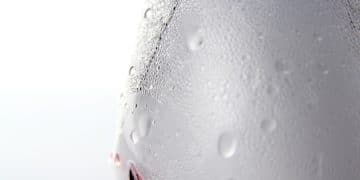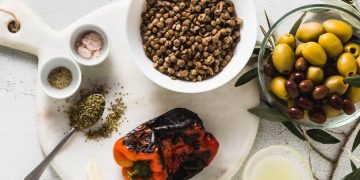How to Stay Hydrated: Your 2025 Guide to Optimal Water Intake

Achieving optimal hydration is paramount for overall health, influencing everything from cognitive function to metabolic processes, and this guide provides an updated 2025 perspective on effective daily water intake strategies for adults.
In a world that continuously moves at an accelerated pace, prioritizing personal health often takes a backseat. Yet, one of the most fundamental aspects of well-being, often overlooked, is proper hydration. This definitive guide on How to Stay Hydrated: The Updated 2025 Guide to Drinking Enough Water delves into the science and practical strategies to ensure your body functions at its peak.
Understanding the Science of Hydration
Hydration is more than just quenching thirst; it’s a dynamic process essential for virtually every bodily function. Water constitutes a significant portion of our body weight and plays critical roles in nutrient transport, temperature regulation, joint lubrication, and waste elimination. Without adequate fluid intake, these systems can falter, leading to a myriad of health issues.
The human body is an intricate network of cells, tissues, and organs, all relying heavily on water to perform their functions efficiently. From the blood that carries oxygen and nutrients throughout your system to the digestive fluids breaking down food, water is an indispensable component. Even the subtle processes, like maintaining skin elasticity or ensuring proper brain function, are deeply tied to your hydration status.
The Role of Water in Bodily Functions
Water acts as a solvent, enabling biochemical reactions vital for life. It helps in the absorption of nutrients from our food and in the excretion of waste products through urine. When you consider the sheer volume of processes that depend on water, its importance becomes unequivocally clear. Dehydration, even mild, can significantly impede these functions.
- Nutrient Transport: Water is the medium through which vitamins, minerals, and glucose are delivered to cells.
- Temperature Regulation: Through sweating, water helps dissipate heat, maintaining a stable body temperature.
- Joint Lubrication: Synovial fluid, primarily water, reduces friction between bones, allowing smooth movement.
- Waste Elimination: Kidneys use water to filter waste and toxins, which are then expelled as urine.
Beyond these foundational roles, water also impacts mood, energy levels, and cognitive performance. Studies consistently show that even slight dehydration can lead to fatigue, reduced concentration, and impaired memory. Staying properly hydrated, therefore, is directly linked to both physical vitality and mental clarity, making it a cornerstone of comprehensive health. This understanding forms the basis for developing effective daily hydration habits that resonate with individual needs and lifestyles.
Daily Water Intake: What’s the Right Amount?
The age-old question of “how much water should I drink?” has no one-size-fits-all answer, yet general guidelines and evolving research provide valuable insights. The traditional advice of “eight glasses a day” serves as a starting point, but individual needs vary significantly based on factors like activity level, climate, and overall health. In 2025, a more personalized and nuanced approach to daily water intake is advocated, moving beyond rigid rules to embrace a more adaptive strategy.
Factors Influencing Your Water Needs
Several variables dictate your optimal daily fluid intake. Your physical activity level is a primary determinant; rigorous exercise leads to increased fluid loss through sweat, necessitating greater replenishment. Climate also plays a crucial role; hot, humid environments accelerate fluid evaporation from the skin, while even cold, dry climates can increase respiratory water loss. Furthermore, certain health conditions, such as fever, vomiting, or diarrhea, significantly elevate hydration requirements. Pregnant or breastfeeding individuals also need additional fluids to support their bodies and the developing baby.
- Physical Activity: More intense and prolonged exercise means higher water needs.
- Climate: Hot, humid, or high-altitude environments increase fluid loss.
- Health Status: Illnesses, fever, or certain medical conditions might require extra hydration.
- Pregnancy and Breastfeeding: Increased fluid needs to support maternal and infant health.
While a general benchmark for adequate fluid intake remains helpful, focusing solely on water can be misleading. Foods rich in water, such as fruits and vegetables, contribute significantly to your daily fluid intake. These sources also provide essential electrolytes and nutrients, offering a holistic approach to hydration. Listening to your body’s signals, such as thirst, and observing urine color are practical indicators of your hydration status. In 2025, the emphasis is on a dynamic balance, adjusting intake based on daily demands rather than adhering to a static target.

Best Practices for Consistent Hydration
Achieving consistent hydration is less about rigidly tracking ounces and more about integrating mindful habits into your daily routine. By making small, strategic adjustments, maintaining optimal fluid levels becomes an effortless part of your lifestyle. These practices extend beyond simply drinking water, encompassing choices that support overall fluid balance.
Incorporating hydration into your routine can begin the moment you wake up. A glass of water first thing in the morning can kickstart your metabolism and rehydrate your body after hours of sleep. Throughout the day, strategic sips are more effective than rushing to consume large volumes at once. This steady intake helps your body absorb fluids more efficiently and prevents the discomfort of feeling bloated.
Leveraging Technology and Smart Habits
In 2025, technology offers numerous tools to assist with hydration. Smartphone apps, for instance, can send reminders to drink water and track your daily intake, providing a visual representation of progress. Smart water bottles that connect to these apps can even monitor your consumption automatically. However, technology should complement, not replace, mindful engagement with your body’s signals.
- Set Regular Alarms: Use a phone alarm or app to remind you to drink water every hour or two.
- Keep Water Visible: Place water bottles or glasses in prominent locations at home, work, and in your car.
- Use a Reusable Bottle: A personal water bottle encourages consistent sips throughout the day.
- Infused Water: Add fruits, vegetables, or herbs for flavor, making water more appealing.
Beyond structured reminders, integrating water into your meal routines is highly effective. Drinking a glass of water before each meal not only aids digestion but can also help regulate appetite. Opting for water as your primary beverage choice over sugary drinks is another crucial step. Furthermore, consider keeping a water bottle at your desk, in your car, and by your bedside to ensure fluids are always within reach. These small, consistent efforts compound over time, fostering a habit of consistent and adequate hydration without feeling like a chore.
Hydration Beyond Water: Foods and Beverages
While water is undoubtedly the cornerstone of hydration, it’s essential to recognize that a significant portion of our daily fluid intake comes from foods and other beverages. This holistic approach to hydration ensures we’re not only consuming enough liquids but also benefiting from the electrolytes, vitamins, and minerals found in nutrient-rich sources. Diversifying your fluid intake can make meeting your hydration goals more enjoyable and sustainable.
Many fruits and vegetables are remarkably high in water content, contributing substantially to your daily hydration. Incorporating these into your diet offers a delicious and nutritious way to boost fluid levels. For instance, watermelon, strawberries, and cantaloupe are not just refreshing; they’re packed with water. Similarly, vegetables like cucumber, celery, and lettuce can add both hydration and fiber to your meals. These foods provide a slow release of fluids, which can be more beneficial than drinking large amounts of water at once.
Hydrating Foods and Their Benefits
Beyond their water content, hydrating foods also supply essential electrolytes like potassium, sodium, and magnesium, which are crucial for maintaining fluid balance and nerve function. When we sweat, we lose these electrolytes, and replenishing them through food can be just as important as drinking plain water. This is particularly relevant after intense physical activity or during hot weather.
- Water-Rich Fruits: Watermelon (92% water), strawberries (91%), grapefruit (90%).
- Water-Rich Vegetables: Cucumber (95% water), lettuce (96%), celery (95%).
- Soups and Broths: Excellent sources of fluids and electrolytes, especially hydrating.
- Dairy and Alternatives: Milk, yogurt, and plant-based milks contribute to fluid intake and offer nutrients.
Beverages like herbal teas, coconut water, and even moderate amounts of coffee and milk can also count towards your daily fluid goal. While coffee has a diuretic effect, the net fluid contribution is still positive for most people when consumed in moderation. Coconut water is a natural source of electrolytes, making it a popular choice for post-exercise rehydration. By exploring a wider range of hydrating foods and beverages, you can make your daily intake more varied and pleasurable, ensuring consistent and effective hydration throughout the day.
Addressing Common Hydration Challenges
Despite the known benefits, many individuals face hurdles in maintaining optimal hydration. From forgetting to drink water to personal preferences, these challenges can impede consistent intake. Identifying and strategically addressing these common issues is key to fostering sustainable hydration habits. Understanding why you might struggle can lead to tailored solutions that work for your lifestyle.
One of the most frequent complaints is simply forgetting to drink water amidst a busy schedule. Modern life often involves long hours, high-stress environments, and numerous distractions, pushing hydration to the back of our minds. Another challenge stems from a dislike of plain water; for some, the lack of flavor makes it unappealing, leading them to opt for less healthy, sugary alternatives. This is where creative solutions become crucial.
Overcoming Hydration Obstacles
Forgetting to drink can often be remedied by integrating hydration into existing routines. For example, make it a rule to drink a glass of water before every meal, after using the restroom, or during specific breaks at work. Setting reminders on your phone or using a smart water bottle can also be highly effective. If plain water isn’t enticing, explore flavor infusions using natural ingredients. Lemon, cucumber, mint, or berries can transform plain water into a delightful and refreshing beverage without adding sugar.
- Flavor Infusion: Add fruits, vegetables, or herbs to water for natural flavor without added sugar.
- Hydration Reminders: Use apps, smart bottles, or set alarms to prompt regular water intake.
- Carry a Bottle: A visible, accessible water bottle acts as a constant reminder and makes drinking easier.
- Make it a Habit: Link drinking water to existing daily activities like brushing teeth or checking emails.
Moreover, misunderstanding thirst signals can be a challenge. Often, by the time you feel thirsty, you’re already in a mild state of dehydration. Practicing proactive hydration, drinking water at regular intervals even before thirst sets in, helps maintain a steady fluid balance. For those new to consistent hydration, a gradual increase in intake can prevent discomfort. Instead of immediately aiming for a large amount, slowly increase your daily consumption over a few weeks, allowing your body to adjust comfortably. By addressing these common challenges with practical and personalized strategies, achieving consistent hydration becomes a more attainable goal.
Hydration and Specific Lifestyles/Conditions
While general hydration guidelines are widely applicable, certain lifestyles and health conditions necessitate a more tailored approach to fluid intake. Understanding these specific needs ensures optimal health and performance for diverse groups, moving beyond generic advice to embrace precision hydration strategies. The interaction between fluid balance and unique physiological demands is crucial for personalized well-being.
Athletes, for instance, experience significantly higher fluid losses through sweat, especially during intense or prolonged physical activity. Their hydration strategies must account for electrolyte replenishment, not just water. Similarly, individuals living in hot climates or at high altitudes face increased risk of dehydration due to environmental factors. For these groups, a proactive and often more aggressive hydration plan is imperative to prevent adverse health effects.
Tailoring Hydration for Unique Needs
For athletes, the timing and composition of fluid intake are critical. Pre-exercise hydration, fluid consumption during activity, and post-exercise rehydration with consideration for electrolytes are all vital. In contrast, individuals managing certain health conditions, such as kidney disease or heart failure, may have fluid restrictions, requiring careful medical guidance for their hydration plan. Pregnant and breastfeeding women also have elevated fluid needs to support both maternal health and fetal/infant development.
- Athletes: Focus on electrolyte-rich beverages and consistent hydration before, during, and after training.
- Elderly Individuals: May have a diminished thirst sensation; scheduled water intake is crucial.
- Pregnant/Breastfeeding Women: Increased fluid requirements to support metabolism and milk production.
- Individuals with Illness: Fever, vomiting, or diarrhea necessitate increased fluid and electrolyte intake.
Children’s hydration needs also differ from adults, requiring consistent encouragement to drink water, particularly during active play. Their smaller body size and higher metabolic rate mean they can dehydrate more quickly. Even for those recovering from illness, proper fluid intake is crucial for recovery, helping the body flush out toxins and regenerate. Consulting healthcare professionals for personalized advice is always recommended for individuals with specific medical conditions or those embarking on new, demanding lifestyles, ensuring that hydration strategies are safe, effective, and perfectly aligned with individual health requirements.
Innovations in Hydration: The Future of Drinking Water
The landscape of hydration is continually evolving, driven by scientific advancements and technological innovation. Looking ahead to 2025 and beyond, we see an exciting array of new products, monitoring devices, and personalized approaches designed to optimize fluid intake. These innovations promise to make hydration more efficient, accessible, and aligned with individual physiological needs, transforming how we perceive and manage our daily water consumption.
One significant area of development is the rise of smart hydration technology. Devices that go beyond simple reminders are becoming more sophisticated, offering real-time feedback on hydration levels, urine output, and even sweat rates during exercise. These advanced trackers can analyze biometric data and environmental factors to recommend precise fluid intake, moving away from generic guidelines towards highly personalized hydration prescriptions.
Emerging Technologies and Personalized Hydration
The future of hydration also includes advancements in the water itself. Enhanced water products, often infused with specific minerals, vitamins, or adaptogens, are entering the market, promising benefits beyond basic rehydration. While some of these products warrant further scientific scrutiny, they reflect a growing consumer demand for functional beverages that support overall well-being. Furthermore, sustainable and accessible water solutions are a key focus, including advanced filtration systems and eco-friendly packaging that minimize environmental impact.
- Wearable Hydration Sensors: Devices that non-invasively monitor hydration levels through sweat or skin conductance.
- AI-Powered Hydration Apps: Apps that learn individual patterns, predict needs, and provide tailored hydration plans.
- Water Quality Monitoring: Portable devices that test water purity and mineral content on the go.
- Sustainable Water Solutions: Innovations in water purification, recycling, and eco-friendly bottling.
Beyond technology and products, there’s a growing emphasis on understanding the gut microbiome’s role in hydration and nutrient absorption, potentially leading to probiotic-infused hydration solutions. The integration of personalized nutrition with hydration science is also on the horizon, where dietary recommendations will consider an individual’s unique fluid and electrolyte needs. These innovations underscore a future where staying hydrated is not just a health recommendation but an optimized, data-driven, and highly personal endeavor, ensuring every individual can achieve their optimal fluid balance with greater ease and precision.
| Key Point | Brief Description |
|---|---|
| 💧 Daily Intake | Individual water needs vary by activity, climate, and health. Listen to your body. |
| 🍎 Food Sources | Many fruits and vegetables are high in water, contributing to total fluid intake. |
| ⚙️ Smart Habits | Use reminders, visible bottles, and flavored water to make hydration consistent. |
| 💡 Future Trends | Innovations include wearable sensors and AI-powered apps for personalized hydration. |
Frequently Asked Questions About Hydration
While the “eight glasses a day” rule is a common starting point, individual water needs vary greatly. Factors like activity level, climate, and overall health influence optimal intake. It’s best to listen to your body’s thirst signals and observe your urine color as indicators, aiming for pale yellow.
While many fruits and vegetables (like watermelon, cucumber) have high water content and contribute significantly to hydration, it’s rarely sufficient to meet total daily fluid needs. Pairing water-rich foods with direct water intake is the most effective strategy for optimal hydration.
Common signs of dehydration include thirst, dry mouth, infrequent urination, dark urine, fatigue, and dizziness. More severe symptoms can include confusion and rapid heart rate. It’s crucial to address these signs promptly by increasing fluid intake.
Yes, excessive water intake, known as hyponatremia, can dilute sodium levels in the blood, leading to serious health issues. This is rare but can occur, especially in endurance athletes or individuals with certain medical conditions. Always drink according to thirst and activity levels.
For most people, plain water is sufficient for hydration. Sports drinks, which contain electrolytes and carbohydrates, are generally only necessary for individuals engaging in prolonged, intense exercise (over an hour) or heavy sweating, to replenish lost salts and energy. For casual activity, they often provide unnecessary sugars.
Conclusion
Maintaining optimal hydration is not merely about surviving; it’s about thriving. As we navigate the complexities of modern life, understanding and prioritizing our fluid intake becomes an indispensable pillar of holistic health. From grasping the fundamental science to adopting smart, personalized habits and embracing future innovations, the journey to staying adequately hydrated is an ongoing commitment to well-being. By integrating these strategies, we empower our bodies to perform at their best, ensuring vitality, clarity, and resilience in every facet of life. Consistent hydration is an investment in your health that yields profound, lasting benefits.





